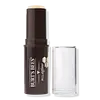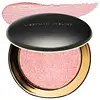Burt's Bees All Aglow Highlighter Stick Versus Westman Atelier Super Loaded Tinted Cream Highlighter
What's inside
What's inside
 Key Ingredients
Key Ingredients

 Benefits
Benefits

 Concerns
Concerns

 Ingredients Side-by-side
Ingredients Side-by-side

Simmondsia Chinensis Seed Oil
EmollientHelianthus Annuus Seed Oil
EmollientCera Alba
EmollientBeeswax
Emulsion StabilisingHelianthus Annuus Seed Wax
Skin ConditioningMica
Cosmetic ColorantCocos Nucifera Oil
MaskingRaphanus Sativus Seed Extract
Skin ConditioningLauryl Laurate
Skin ConditioningTheobroma Grandiflorum Seed Butter
Skin ConditioningSilica
AbrasiveRosmarinus Officinalis Leaf Extract
AntimicrobialTocopherol
AntioxidantLinoleic Acid
CleansingLinolenic Acid
CleansingWater
Skin ConditioningAroma
Linalool
PerfumingIron Oxides
Titanium Dioxide
Cosmetic ColorantCI 75470
Cosmetic ColorantSimmondsia Chinensis Seed Oil, Helianthus Annuus Seed Oil, Cera Alba, Beeswax, Helianthus Annuus Seed Wax, Mica, Cocos Nucifera Oil, Raphanus Sativus Seed Extract, Lauryl Laurate, Theobroma Grandiflorum Seed Butter, Silica, Rosmarinus Officinalis Leaf Extract, Tocopherol, Linoleic Acid, Linolenic Acid, Water, Aroma, Linalool, Iron Oxides, Titanium Dioxide, CI 75470
Caprylic/Capric Triglyceride
MaskingOctyldodecanol
EmollientMica
Cosmetic ColorantSimmondsia Chinensis Seed Oil
EmollientSilica
AbrasiveCera Alba
EmollientHelianthus Annuus Seed Wax
Skin ConditioningCalcium Sodium Borosilicate
Aroma
Octyldodecyl Myristate
EmollientCapparis Spinosa Fruit Extract
Skin ConditioningEthylhexyl Palmitate
EmollientDimethylmethoxy Chromanol
AntioxidantTrihydroxystearin
Skin ConditioningSodium Hyaluronate
HumectantTin Oxide
AbrasiveCI 77891
Cosmetic ColorantIron Oxides
CI 75470
Cosmetic ColorantCaprylic/Capric Triglyceride, Octyldodecanol, Mica, Simmondsia Chinensis Seed Oil, Silica, Cera Alba, Helianthus Annuus Seed Wax, Calcium Sodium Borosilicate, Aroma, Octyldodecyl Myristate, Capparis Spinosa Fruit Extract, Ethylhexyl Palmitate, Dimethylmethoxy Chromanol, Trihydroxystearin, Sodium Hyaluronate, Tin Oxide, CI 77891, Iron Oxides, CI 75470
Ingredients Explained
These ingredients are found in both products.
Ingredients higher up in an ingredient list are typically present in a larger amount.
Aroma refers to an ingredient, or mixture of ingredients, that impart or mask a flavor.
The name is slightly confusing. This is because INCI associates aroma with flavor instead of smell.
Here is the official definition from the The International Cosmetic Ingredient Dictionary and Handbook:
“Aroma is a term for ingredient labeling used to identify that a product contains a material or combination of materials normally added to a cosmetic to produce or to mask a particular flavor.”
INCI shows the only purpose of aroma to be "flavouring".
However, due to regulation differences, some companies may use aroma in place of parfum.
In Canada, this ingredient only has to be listed in concentrations above 1%.
Learn more about AromaCera alba is beeswax, or the wax used by bees to make honeycombs. It is a texture-enhancer and emollient. A study from 2003 found beeswax to be a stronger emollient than ingredients such as petroleum jelly.
As an emollient, beeswax helps hydrate the skin by creating a barrier on top. This barrier traps moisture in.
Emulsifiers help prevent ingredients from separating. This helps create consistent texture.
The structure of beeswax is mainly long-chain alcohols and the esters of fatty acids.
There are three types of beeswax: yellow, white, and absolute. Yellow is pure beeswax taken from the honeycomb. White beeswax is created by filtering or bleaching yellow beeswax. Absolute beeswax is created by treating beeswax with alcohol. Beeswax used in cosmetics are purified.
Beeswax has been used throughout history and even in prehistoric times. Some common uses for beeswax still used today are making candles, as a waterproofing agent, and polish for leather.
Learn more about Cera AlbaCi 75470 is a bright-red pigment. It is AKA carmine.
Carmine is derived from insects such as the cochineal beetle. This ingredient has been used as a natural dye for over 2000 years.
Helianthus Annuus Seed Wax is created from the common sunflower.
Sunflower seed wax is made up of long chain non-glyceride esters, a small amount of fatty alcohols, and fatty acids.
This ingredient is often used to enhance the texture of products. The fatty acid properties also help hydrate the skin.
Learn more about Helianthus Annuus Seed WaxMica is a naturally occurring mineral used to add shimmer and color in cosmetics. It can also help improve the texture of a product or give it an opaque, white/silver color.
Serecite is the name for very fine but ragged grains of mica.
This ingredient is often coated with metal oxides like titanium dioxide. Trace amounts of heavy metals may be found in mica, but these metals are not harmful in our personal products.
Mica has been used since prehistoric times throughout the world. Ancient Egyptian, Indian, Greek, Roman, Aztec, and Chinese civilizations have used mica.
Learn more about MicaSilica, also known as silicon dioxide, is a naturally occurring mineral. It is used as a fine, spherical, and porous powder in cosmetics.
Though it has exfoliant properties, the function of silica varies depending on the product.
The unique structure of silica enhances the spreadability and adds smoothness, making it a great texture enhancer.
It is also used as an active carrier, emulsifier, and mattifier due to its ability to absorb excess oil.
In some products, tiny microneedles called spicules are made from silica or hydrolyzed sponge. When you rub them in, they lightly polish away dead skin layers and enhance the penetration of active ingredients.
Learn more about SilicaThis oil comes from the seeds of the desert shrub called Jojoba. It is more commonly known as jojoba oil, a non-comedogenic oil.
Jojoba oil does not contain fragrance and has many fatty-acids, making it a great soothing ingredient.
It also contains Vitamin E, a great moisturizing ingredient. Vitamin E is also an antioxidant and protects your skin against oxidative damage.
This ingredient humectant properties, meaning it helps draw moisture from the air. This helps keep your skin hydrated.
While jojoba has antibacterial properties, it is only able to kill some strains of bacteria.
Studies also show it helps in wound healing. In fact, Indigenous cultures have used jojoba as a moisturizer and to help treat burns for centuries.
Fun fact: Jojoba oil similar to natural human skin sebum, so it has a great effect on dry skin. It is also promising with helping to regulate sebum production.
Due to its fatty acid content, Jojoba oil may not be fungal acne safe. We recommend speaking with a professional if you have any concerns.
Learn more about Simmondsia Chinensis Seed OilThis ingredient is a combination of red, black, and yellow iron oxide pigments. This combination of colors is usually found in foundation, because it results in a "skin" color.